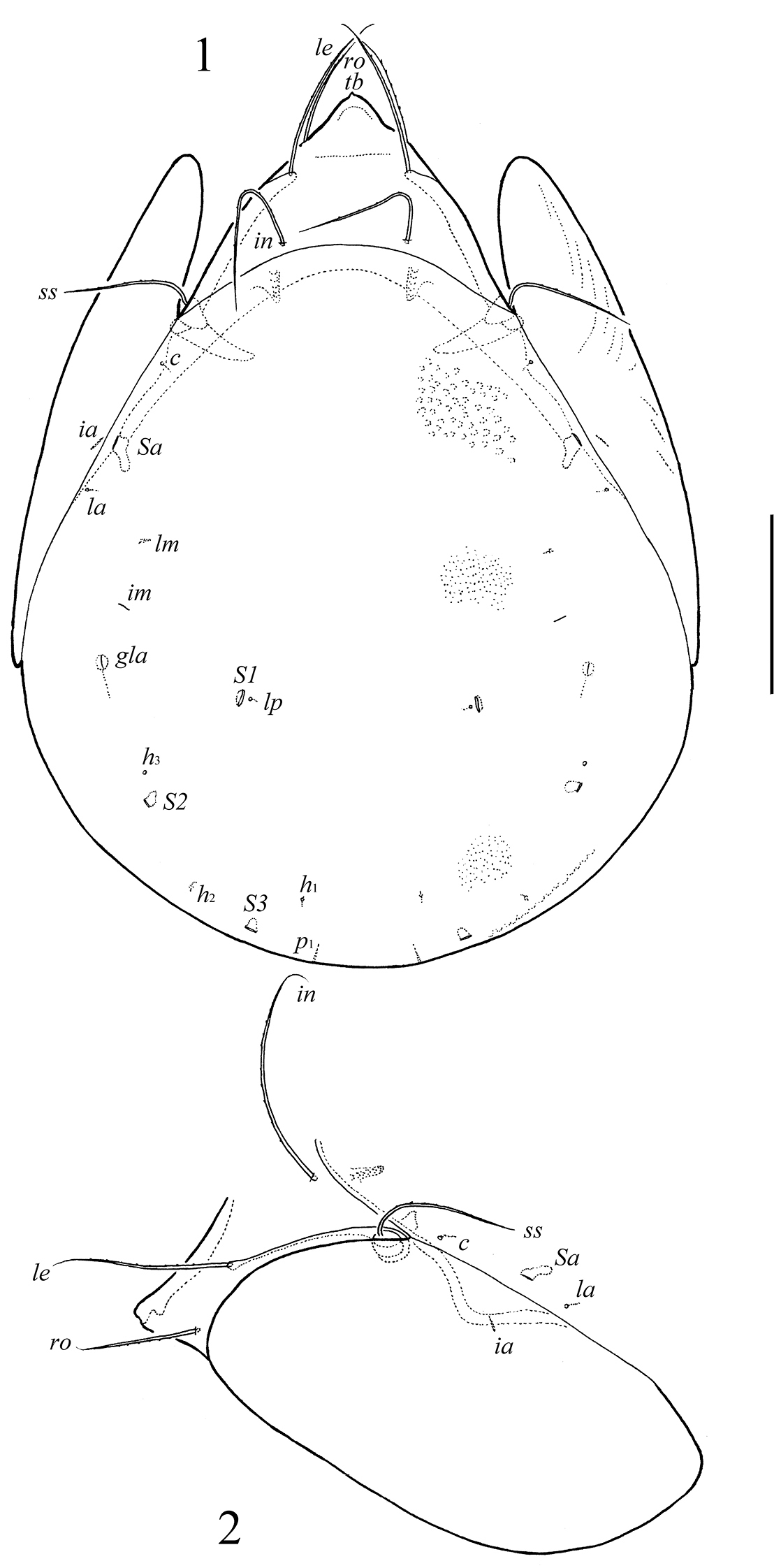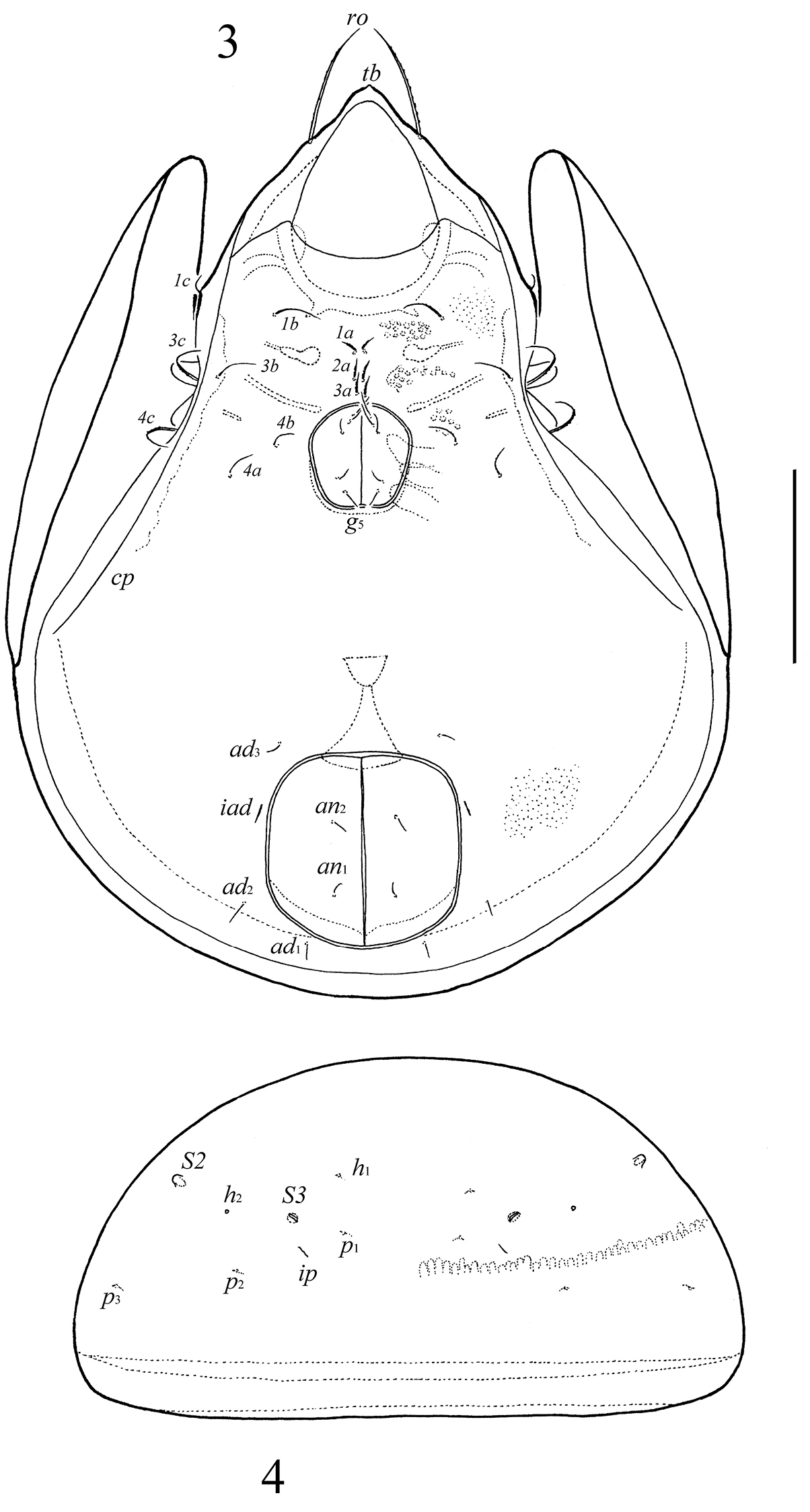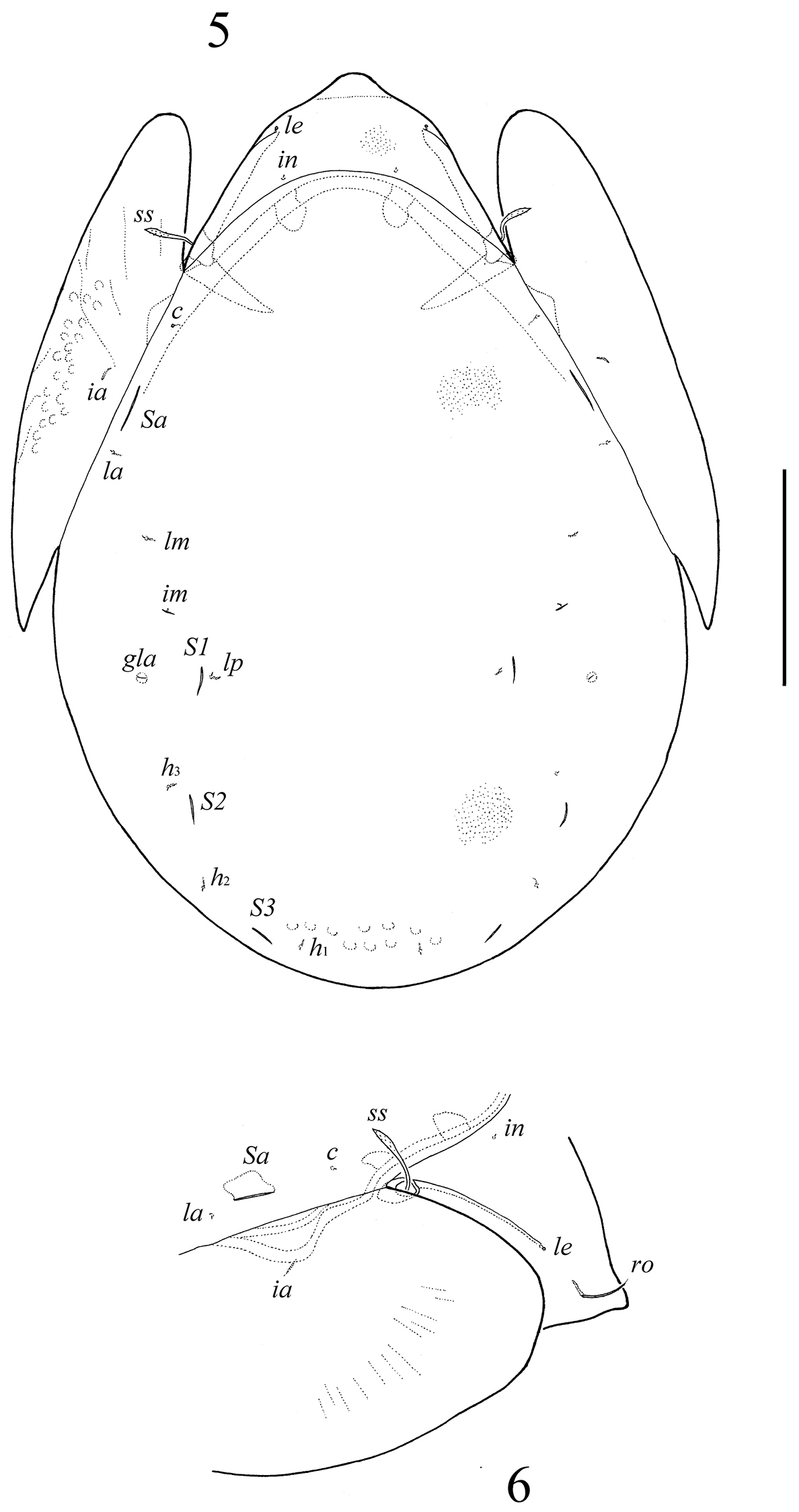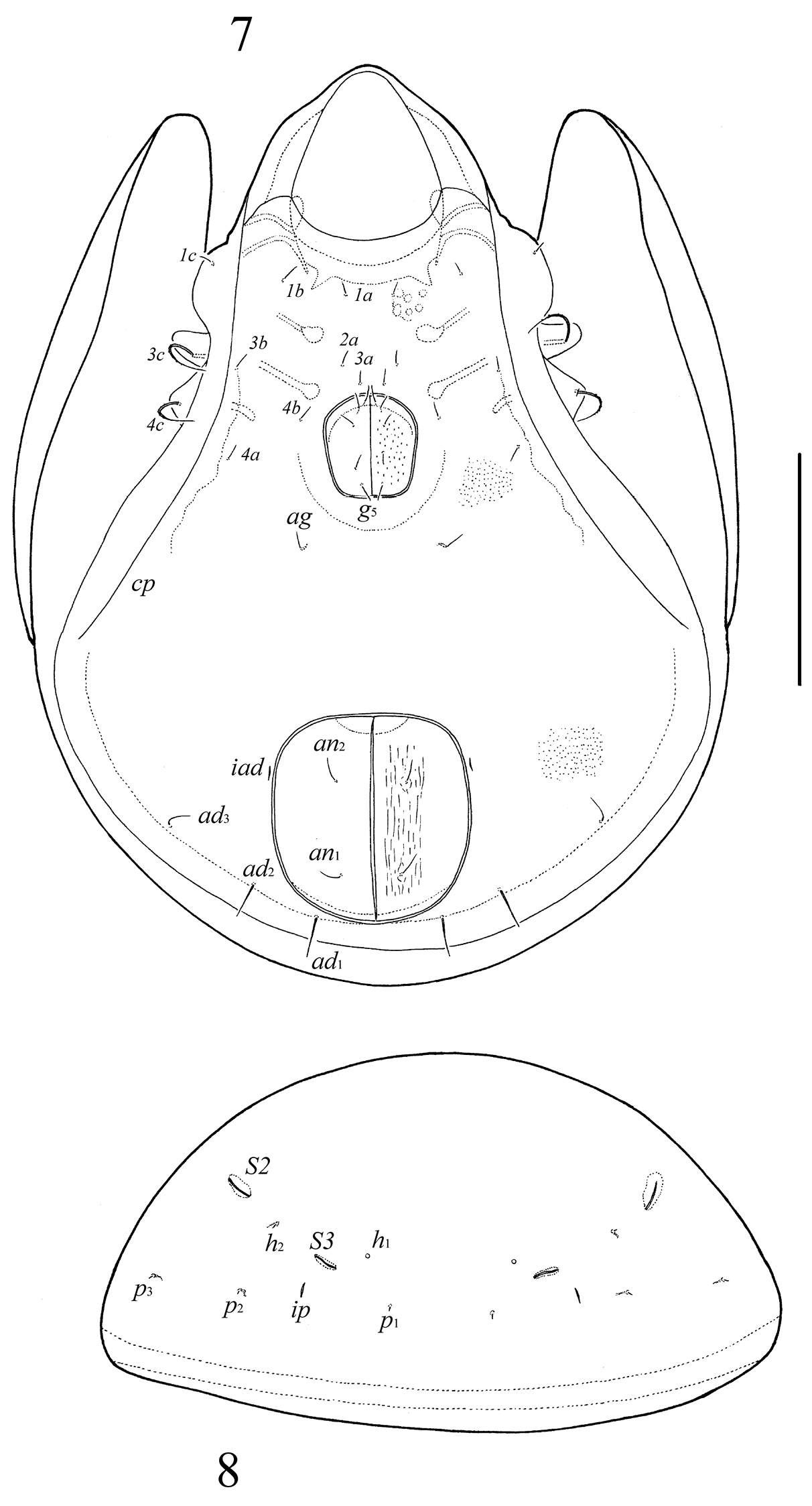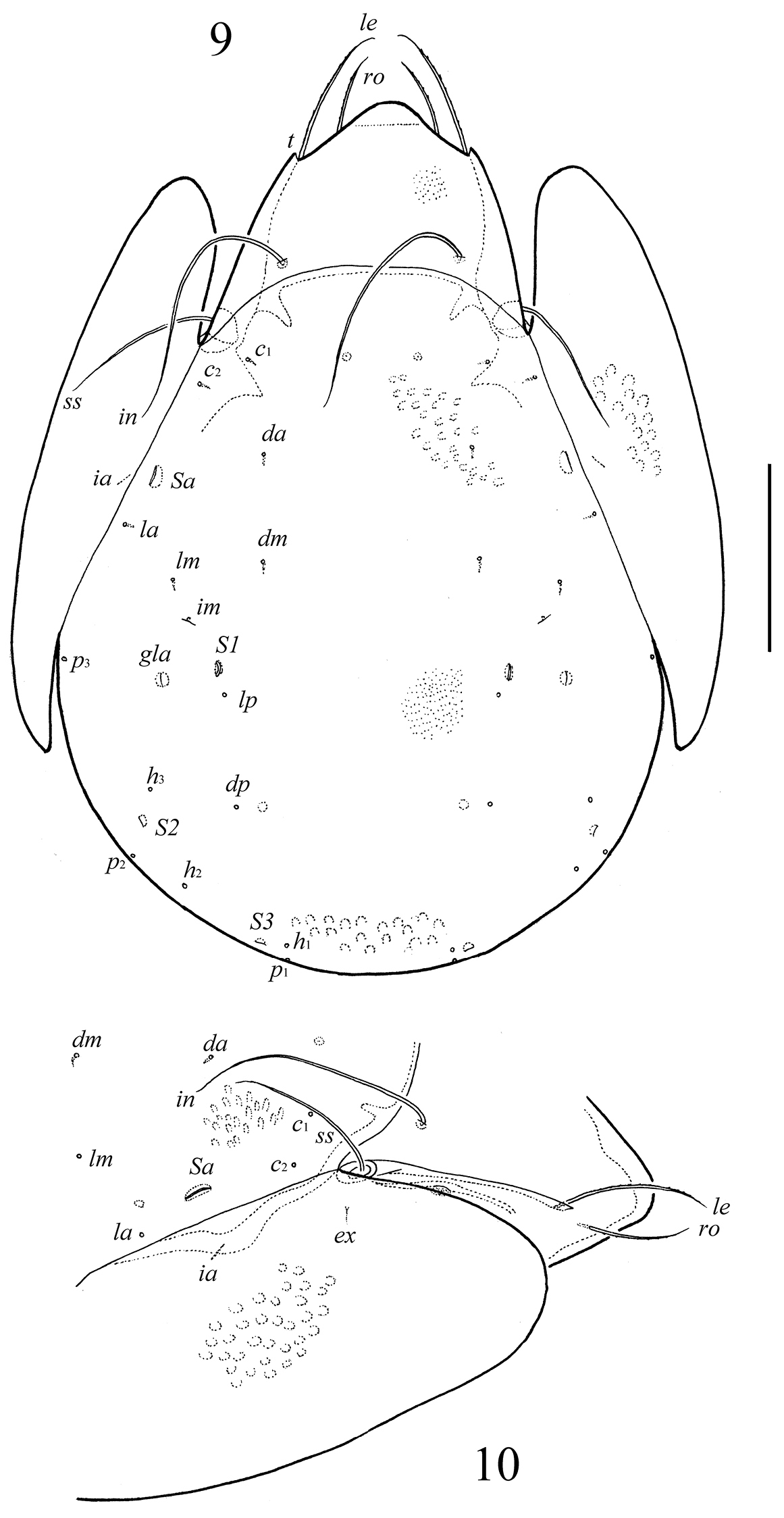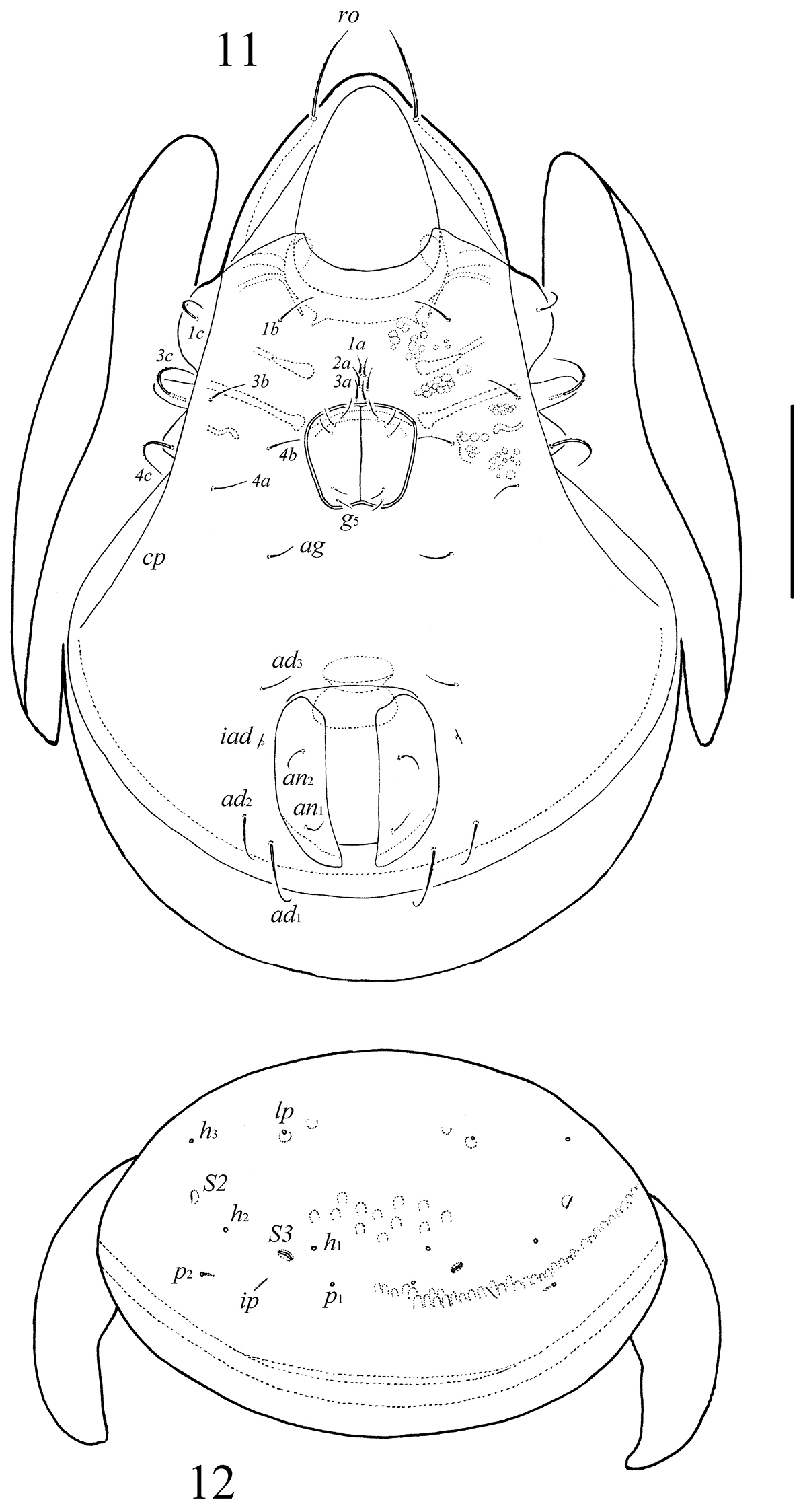






Citation: Ermilov SG, Martens J (2014) Three new species of the subgenus Neoribates (Neoribates) (Acari, Oribatida, Parakalummidae) from Nepal. ZooKeys 431: 19–32. doi: 10.3897/zookeys.431.8120
Three new parakalummid mites of the subgenus Neoribates (Neoribates), N. (N.) parabulanovae sp. n., N. (N.) paramacrosacculatus sp. n. and N. (N.) pararotundus sp. n., are described from Nepalese soils. Neoribates (Neoribates) parabulanovae sp. n. is morphologically most similar to N. (N.) bulanovae Grishina, 2009, N. (N.) rotundus Aoki, 1982 and N. (N.) setiger Balogh & Mahunka, 1978, however, it differs from N. (N.) bulanovae by the body length, body and leg integument, morphology of bothridial setae, absence of aggenital setae, length of interlamellar setae and location of adanal setae ad3; from N. (N.) rotundus by the body size, body integument, morphology of bothridial setae and length of interlamellar setae; from N. (N.) setiger by the body size, number of genital setae and absence of aggenital setae. Neoribates (Neoribates) paramacrosacculatus sp. n. is morphologically most similar to N. (N.) macrosacculatus Aoki, 1966, however, it differs from the latter by the body size, body integument, length and morphology of bothridial setae, number of genital setae, absence of lamellar setae and length of interlamellar setae. Neoribates (Neoribates) pararotundus sp. n. is morphologically most similar to N. (N.) rotundus, however, it differs from the latter by the number of notogastral setal alveoli, body integument and length of interlamellar setae.
Oribatid mites, new species, Neoribates (Neoribates), Nepal
During a taxonomic survey of Nepalese oribatid mite fauna
Results of the Himalaya Expeditions (1980, 1983) of Dr. Jochen Martens.
Neoribates (Neoribates) has a cosmopolitan distribution except the Ethiopian and Antarctic regions, comprises about 40 species (
The collection locality and habitat of the new species are given in the respective "Material examined" sections.
Holotypes and paratypes were mounted in lactic acid on temporary cavity slides for measurement and illustration. The body length was measured in lateral view, from the tip of the rostrum to the posterior edge of the ventral fig. The notogastral width refers to the maximum width in dorsal aspect. Lengths of body setae were measured in lateral aspect. All body measurements are presented in micrometers. Formula for leg setation is given in parentheses according to the sequence trochanter–femur–genu–tibia–tarsus (famulus included). Formula for leg solenidia is given in square brackets according to the sequence genu–tibia–tarsus. General terminology used in this paper follows that of
http://zoobank.org/D38AE3B5-F33D-4CA8-8CCA-2836F9EE1C00
Body size: 946–1062 × 697–763. Body surface densely microfoveolate; anterior part of rostrum, subcapitular genae and leg segments III, IV with larger, sparse foveoles. Rostral, lamellar and interlamellar setae well developed, barbed. Bothridial setae setiform, slightly barbed. Saccular openings short. Subcapitular setae h and m longer than a; h thickest. Five pairs of genital setae present. Aggenital setae absent. Adanal setae short, ad3 inserted in preanal position. Tridactylous.
Measurements. Body length: 1012 (holotype), 946–1062 (four paratypes); notogaster width: 697 (holotype), 713–763 (four paratypes).
Integument. Body color brown. Body surface densely microfoveolate (diameter of microfoveoles less than 1; visible only under high magnification in dissected specimens, × 1000). Anterior part of rostrum, subcapitular genae and leg segments III, IV with larger, sparse foveoles (their diameter up to 4).
Prodorsum. Rostrum weakly protruding, rounded. A small tubercle (tb) is present in medial part nearly to rostrum. Lamellae distinct, reaching the insertions of alveoli of lamellar setae. Rostral setae (ro, 118–131) setiform, barbed. Lamellar (le, 192–200) and interlamellar (in, 278–287) setae setiform, with short attenuate tip, barbed. Exobothridial setae short (8), thin, smooth. Bothridial setae (ss, 192–200) setiform, slightly barbed on dorsal side.
Notogaster. Anterior notogastral margin convex. Notogastral setae represented by 10 pairs of alveoli or microsetae (1). Four pairs of sacculi (Sa, S1–S3) present, their openings short, thin. Alveoli/microsetae lp inserted laterally to S1. Opisthonotal gland openings (gla) located laterally to sacculi S1. Lyrifissures im located between gla and setal alveolus lm.
Gnathosoma. Generally, morphology of subcapitulum, palps and chelicerae typical as for most Neoribates (Neoribates) (see for example
Epimeral and lateral podosomal regions. Epimeral setal formula: 3–1–3–3. All setae setiform, slightly barbed; 1a, 1c, 2a, 3a (32–36) shorter than 1b, 3b, 4a, 4b (61–65) and 3c, 4c (77–86). Setae 1a, 2a, 3a located close to each other. Pedotecta I, II, discidia and circumpedal carinae (cp) normally developed.
Anogenital region. Five pairs of genital (g1–g5, 32–36), three pairs of adanal (ad1–ad3, 24–32) and two pairs of anal (an1, an2, 24–32) setae setiform, with sparse barbs. Genital setae g1 and g2 little thicker than g3–g5. Aggenital setae and their alveoli absent. Lyrifissures iad located in paraanal position, usually weakly diagonally to the anal aperture. Adanal setae ad3 inserted in preanal position.
Legs. Generally, morphology of leg segments, setae and solenidia typical for Neoribates (Neoribates) (see for example:
Five specimens (holotype: male; four paratypes: three males, one female) of Neoribates (Neoribates) parabulanovae sp. n. are from central Nepal, 28°34'N, 83°98'E, 2100 m a.s.l., Kaski District, above Dhumpus, broadleaved forest, soil, 08–10.V.1980, collected by J. Martens & A. Ausobsky.
The holotype and one paratype are deposited in the collection of the Senckenberg Institution Frankfurt, Germany; three paratypes are deposited in the collection of the Tyumen State University Museum of Zoology, Tyumen, Russia.
The prefix para is Latin meaning “near” and refers to the similarity between the new species and the species Neoribates (Neoribates) bulanovae Grishina, 2009.
Neoribates (Neoribates) parabulanovae sp. n. is morphologically similar to Neoribates (Neoribates) bulanovae Grishina, 2009 (see
Neoribates (Neoribates) parabulanovae sp. n., adult: 1 dorsal view 2 lateral view of prodorsum, anterior part of notogaster, and pteromorph. Scale bar 200 μm.
Neoribates (Neoribates) parabulanovae sp. n., adult: 3 ventral view (gnathosoma and legs not illustrated) 4 posterior view of notogaster (pteromorphs not illustrated). Scale bar 200 μm.
Leg setation and solenidia of adult Neoribates (Neoribates) parabulanovae sp. n. (same data for Neoribates (Neoribates) paramacrosacculatus sp. n. and Neoribates (Neoribates) pararotundus sp. n.)<br/>
| Leg | Trochanter | Femur | Genu | Tibia | Tarsus |
| I | v' | d, (l), bv'', v'' | (l), v', σ | (l), (v), φ1, φ2 | (ft), (tc), (it), (p), (u), (a), s, (pv), v', (pl), l'', ε, ω1, ω2 |
| II | v' | d, (l), bv'', v'' | (l), v', σ | (l), (v), φ | (ft), (tc), (it), (p), (u), (a), s, (pv), ω1, ω2 |
| III | l', v' | d, l', ev' | l', σ | l', (v), φ | (ft), (tc), (it), (p), (u), (a), s, (pv) |
| IV | v' | d, ev' | d, l' | d, l', (v) | ft'', (tc), (p), (u), (a), s, (pv) |
Roman letters refer to normal setae (e to famulus), Greek letters to solenidia. Single prime (') marks setae on anterior and double prime (") setae on posterior side of the given leg segment. Parentheses refer to a pair of setae.
http://zoobank.org/EBD29A23-2777-4E3B-9044-61D895BB09F4
Body size: 780–830 × 547–581. Body surface densely microfoveolate. Rostral setae of medium size setiform. Lamellar setae represented by alveoli. Interlamellar setae represented by microsetae. Bothridial setae lanceolate, barbed; stalk and elongate head similar in length. Saccular openings long. Subcapitular setae m longer than a and h; a thickest. Five pairs of genital setae present. Medial parts of anal figs striate. Adanal setae ad3 inserted in lateral position. Tridactylous.
Measurements. Body length: 780 (holotype), 780, 830 (two paratypes); notogaster width: 547 (holotype), 581 (both paratypes).
Integument. Body color brown. Body surface densely microfoveolate (diameter of microfoveoles less than 1; visible only under high magnification in dissected specimens, × 1000). Medial parts of anal figs with longitudinal stria.
Prodorsum. Rostrum weakly protruding, rounded. Lamellae distinct, reaching the insertions of alveoli of lamellar setae. Rostral setae (53) setiform, slightly barbed, present in one paratype and brokened (only basal parts visible) in holotype and one paratype. Lamellar setae represented by alveoli. Interlamellar setae represented by microsetae (2). Exobothridial setae short (12), thin, smooth. Bothridial setae (77–82) of medium size, lanceolate, barbed; stalk and elongate head similar in length.
Notogaster. Anterior notogastral margin convex. Notogastral setae represented by 10 pairs of alveoli or microsetae (2–4). Four pairs of sacculi present, their openings long, thin, slit-like. Alveoli/microsetae lp inserted laterally to S1. Opisthonotal gland openings located laterally to succuli S1. Lyrifissures im located between gla and setal alveolus lm.
Gnathosoma. Generally, morphology of subcapitulum, palps and chelicerae typical as for most Neoribates (Neoribates) (see for example
Epimeral and lateral podosomal regions. Epimeral setal formula: 3–1–3–3. All setae setiform, slightly barbed; 1a, 1b, 1c, 2a, 3a, 3b, 4a, 4b (16–20) shorter than and 3c, 4c (65–69). Setae 1a, 2a, 3a removed from each other. Pedotecta I, II, discidia and circumpedal carinae normally developed.
Anogenital region. Five pairs of genital (12–16), one pair of aggenital (ag, 16–20), three pairs of adanal (ad1, ad2, 24–32, ad3, 20) and two pairs of anal (16–20) setae setiform, indistinctly barbed. Lyrifissures iad located in paraanal position. Adanal setae ad3 inserted in lateral position, removed from the anal aperture.
Legs. Generally, similar to Neoribates (Neoribates) parabulanovae sp. n. (Table 1).
Three specimens (holotype: male; two paratypes: one male and one female) of Neoribates (Neoribates) paramacrosacculatus sp. n. are from eastern Nepal, 27°19'N, 87°78'E, 2770 m a.s.l., Panchthar District, upper course of Mai Majuwa river, pasture Dhorpar Kharka, soil in mixed broadleaved forest, soil, 27–28.VIII.1983, collected by J. Martens & B. Daams.
The holotype and one paratype are deposited in the collection of the Senckenberg Institution Frankfurt, Germany; one paratype is deposited in the collection of the Tyumen State University Museum of Zoology, Tyumen, Russia.
The prefix para is Latin meaning “near” and refers to the similarity between the new species and the species Neoribates (Neoribates) macrosacculatus Aoki, 1966.
Neoribates (Neoribates) paramacrosacculatus sp. n. is morphologically similar to Neoribates (Neoribates) macrosacculatus Aoki, 1966 from the eastern Palaearctic region in having the long openings of notogastral sacculi. However, the new species differs from Neoribates (Neoribates) macrosacculatus by the larger body size (780–830 × 547–581 versus 630–760 × 430–480 in Neoribates (Neoribates) macrosacculatus), foveolate body integument and striate anal figs (versus smooth in Neoribates (Neoribates) macrosacculatus), bothridial setae of medium size, length of stalk not longer than head (versus long, stalk obviously longer than head in Neoribates (Neoribates) macrosacculatus), presence of five pairs of genital setae (versus four pairs in Neoribates (Neoribates) macrosacculatus) and absence of lamellar setae (versus present in Neoribates (Neoribates) macrosacculatus) and presence of very short interlamellar setae (versus long in Neoribates (Neoribates) macrosacculatus).
Neoribates (Neoribates) paramacrosacculatus sp. n., adult: 5 dorsal view 6 lateral view of prodorsum, anterior part of notogaster and pteromorph. Scale bar 200 μm.
Neoribates (Neoribates) paramacrosacculatus sp. n., adult: 7 ventral view (gnathosoma and legs not illustrated) 8 posterior view of notogaster (pteromorphs not illustrated). Scale bar 200 μm.
http://zoobank.org/DB039B08-2436-47C2-B0F6-5750796FC391
Body size: 796–946 × 614–664. Body surface densely microfoveolate. Lamellae with distal tooth. Rostral and lamellar setae setiform, barbed. Interlamellar and bothridial setae setiform, with attenuate tip, smooth. Notogastral setae represented by 14 pairs of alveoli. Saccular openings short. Subcapitular setae h and m longer than a; m thinnest. Five pairs of genital setae present. Adanal setae ad1, ad2 of medium size, with attenuate tip. Adanal setae ad3 inserted in preanal position.
Measurements. Body length: 946 (holotype), 796, 929 (two paratypes); notogaster width: 664 (holotype), 614, 647 (two paratypes).
Integument. Body color dark brown. Body surface densely microfoveolate (diameter of microfoveoles less than 1; visible only under high magnification in dissected specimens, × 1000). Numerous stria located around the genital and anal apertures, poorly visible.
Prodorsum. Rostrum weakly protruding, rounded. Lamellae distinct, reaching the insertions of alveoli of lamellar setae, with distal tooth (t). Rostral (80–98) and lamellar (131–151) setae setiform, barbed. Interlamellar (274–307) and bothridial (155–172) setae setiform, with attenuate tip, smooth. Exobothridial setae short (ex, 12), thin, smooth.
Notogaster. Anterior notogastral margin convex. Notogastral setae represented by 14 pairs of alveoli, one pair of c-row absent. Four pairs of sacculi present, their openings short, thin. Alveoli lp inserted posteriorly to S1. Opisthonotal gland openings located laterally to succuli S1. Lyrifissures im located between gla and setal alveolus lm.
Gnathosoma. Generally, morphology of subcapitulum, palps and chelicerae typical as for most Neoribates (Neoribates) (see for example
Epimeral and lateral podosomal regions. Epimeral setal formula: 3–1–3–3. All setae setiform, slightly barbed; 1a, 1b, 1c, 2a, 3a, 3b, 4a, 4b (32–41) shorter than and 3c, 4c (65–73). Setae 1a, 2a, 3a located close to each other. Pedotecta I, II, discidia and circumpedal carinae normally developed.
Anogenital region. Five pairs of genital (20–24), one pair of aggenital (36–45), three pairs of adanal (ad1, 82–90, ad2, 57–61, ad3, 45–53) and two pairs of anal (36–45) setae setiform (except ad1, ad2 with attenuate tip), slightly barbed. Lyrifissures iad located in paraanal position, diagonally to the anal aperture. Adanal setae ad3 inserted in preanal position.
Legs. Generally, similar to Neoribates (Neoribates) parabulanovae sp. n. (Table 1).
Three specimens (holotype: male; two paratypes: one male and one female) of Neoribates (Neoribates) pararotundus sp. n. are from central Nepal, 27°96' N, 84°97' E, 1100–1300 m a.s.l., Gorkha District, Buri Gandaki valley, riverine forest, between Dobhan and Jagat, soil, 13.VIII.1983, collected by J. Martens & W. Schawaller.
The holotype and one paratype are deposited in the collection of the Senckenberg Institution Frankfurt, Germany; one paratype is deposited in the collection of the Tyumen State University Museum of Zoology, Tyumen, Russia.
The prefix para is Latin meaning “near” and refers to the similarity between the new species and the species Neoribates (Neoribates) rotundus Aoki, 1982.
Neoribates (Neoribates) pararotundus sp. n. is morphologically similar to Neoribates (Neoribates) rotundus Aoki, 1982 from Japan and Taiwan in having the large body size and setiform, smooth bothridial setae. However, the new species differs from Neoribates (Neoribates) rotundus by the presence of 14 pairs of notogastral setal alveoli (versus 10 pairs in Neoribates (Neoribates) rotundus), microfoveolate body integument (versus smooth in Neoribates (Neoribates) rotundus), lamellae with distal tooth (versus without tooth in Neoribates (Neoribates) rotundus) and interlamellar setae longer than bothridial setae (versus shorter in Neoribates (Neoribates) rotundus).
Neoribates (Neoribates) pararotundus sp. n., adult: 9 dorsal view 10 lateral view of prodorsum, anterior part of notogaster and pteromorph. Scale bar 200 μm.
Neoribates (Neoribates) pararotundus sp. n., adult: 11 ventral view (gnathosoma and legs not illustrated) 12 posterior view of notogaster. Scale bar 200 μm.
We cordially thank Dr. Umukusum Shtanchaeva and Prof. Dr. Luis Subías (Universidad Complutense de Madrid, Madrid, Spain) for consultations and two anonymous reviewers for the valuable comments. J. Martens thanks B. Daams, A. Ausobsky and W. Schawaller for helpful companionship during the Nepalese expeditions, as well as the Feldbausch Foundation and the Wagner foundation at Fachbereich Biologie of Mainz University for over the years many annual grants to carry out field work in Asia.
